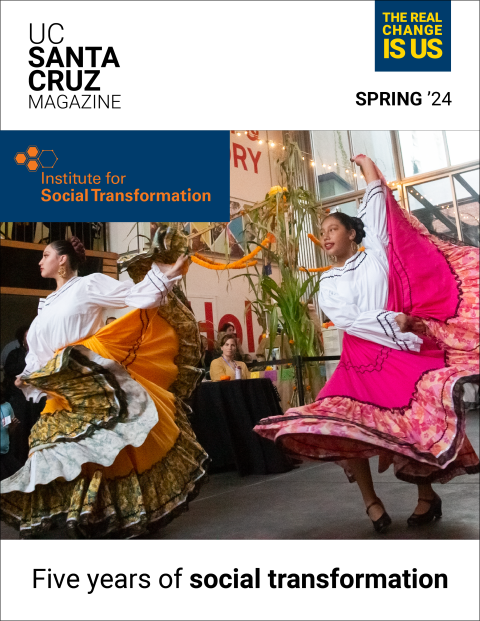When dream expert G. William (Bill) Domhoff — a distinguished professor emeritus and a research professor at UC Santa Cruz — first began studying dreams, he had no idea what was in store.
Domhoff began his career as a founding professor at UC Santa Cruz in 1965, following three years as an assistant professor of psychology at CSU Los Angeles. Now, nearly 62 years since he began studying dreams, Domhoff has developed an updated version of his neurocognitive theory of dreaming, and presented new empirical findings on dream content in his new book, The Neurocognitive Theory of Dreaming: The Where, How, When, What, and Why of Dreams, released October 4 by MIT Press.
The book — Domhoff’s fifth focused on dreams — takes a comprehensive look at the full use of neuroimaging findings in relation to spontaneous thought and dream content. Domhoff now believes there are five separate issues in terms of understanding dreams: neural substrates, cognitive processes, the psychological meaning of dream content, evolutionarily adaptive functions, and historically invented cultural uses. In addition, due to research by others in the 1980s and 1990s, Domhoff emphasizes there is an important development dimension to dreaming: pre-school children do not dream often, and their dreams are not very complex.
Dreaming, he says, is therefore a gradual cognitive achievement.
Domhoff discussed his original dive into dream studies, the changes over time, and the major discoveries in the 1990s that led to his neurocognitive theory of dreaming. His answers have been edited for length and clarity.
What originally sparked your interest in dream research and neuroimaging studies?
I started out in the late 1950s, early 1960s, at a time when the relationship between rapid eye movement sleep — called REM sleep — and dreaming was first coming to the attention of the scientific community. It was very exciting because the eye movements in REM sleep seemed to be related to what people were dreaming. The eye movements and other changes during REM sleep, such as changes in EEG patterns, therefore provided a seemingly objective indicator of dreaming; there seemed to be a perfect correlation between dreaming and this particular stage of sleep.
But that finding soon turned out to be incorrect. People also dream during a state of “Non-REM” sleep in the two or so hours before awakening, called “NREM 2.” However, we continued to make progress in understanding what we actually dream about through quantitative studies of dream content.
What makes a dream a dream?
Dreaming is defined in the neurocognitive theory of dreaming as an intensive and enhanced form of mind-wandering and daydreaming, in which dreamers experience themselves in scenarios that almost always include other human beings and/or animals.
In addition, the other human beings and animals are usually interacting with the dreamer in the context of vivid sensory experiences that usually include seeing and hearing. In fancy terms, dreaming is a form of “embodied simulation.”
What did you find to be the main content of dreams?
People dream most often about their personal concerns.
Whatever’s happening in the daily environment, no matter how momentous, people nevertheless dream most frequently about family members and friends taking part in social interactions. Dreams more often contain critical and aggressive interactions, as well as misfortunes, such as losing keys or making mistakes, than they include friendly interactions or good fortunes. Dreams have a negativity bias, which has also been found to be the case in waking thought. In that sense, dreams are often worse case scenarios.
How did you come to develop a neurocognitive theory of dreaming?
Two unexpected but important findings in the 1990s led to a revival of interest in dreams. Those two findings also led me to realize it was possible to develop a neurocognitive theory of dreaming.
The first of those findings was made possible by the development of functional neuroimaging. Functional neuroimaging studies of REM sleep led to the surprising discovery that only certain parts of the brain are active when we are dreaming. This came as a total surprise because everyone had assumed that the whole brain becomes activated during REM sleep.
At the same time, and quite independently, a large-scale study showed that lesions in specific areas in the brain lead to either the loss of dreaming, or else to the loss of the visual dimension of dreaming. I soon realized that all of the lesions that led to a loss of dreaming occurred in the neural substrates that were activated during REM sleep, and also in NREM 2 sleep in the hours before morning awakening.
Shortly thereafter, a very important finding emerged from waking neuroimaging research. It turns out that the neural network that supports dreaming is part of the waking neural network — called the default network — that supports mind-wandering, daydreaming, and other imaginative forms of thought during waking when the executive and attention networks are relatively deactivated.
The discovery of the default network made it possible to think of dreaming as one form of spontaneous thought. Furthermore, it was also found that drifting, waking thought and daydreaming, much like dreaming, often involves personal concerns. Thus, there was a considerable continuity in the content of dreaming and waking thought, even though dreaming has many unique features. In effect, dreaming has found a home at long last within a thriving research area within the burgeoning field of neurocognitive psychology.
How has your thinking changed about dreams since you first started out 62 years ago?
Dreaming and dream content now seem to be very different from what the clinical theories of the first 60 years of the 20th century led us to believe.
We find very little or no evidence of symbolism in dreams, and there is far less emotion in everyday dreaming than the clinical theories suggested. Furthermore, the developmental and neuroimaging findings provide a basis for understanding at least some of the differences between dreaming and waking thought.
One of the key new concepts in my new book is that dreaming suffers from various cognitive insufficiencies. I now think that children have fewer and less complex dreams because they do not yet have the cognitive abilities that are necessary to express complex forms of thinking. This view turns out to be consistent with the findings in developmental psychology over the last 45 years, which show the gradual development of mental imagery, narrative thinking, imagination, and an autobiographical self.
These findings fit with the fact that young children do not regularly include themselves in dream scenarios until they are ages 5-7, and their dreams are not fully adultlike in their complexity until ages 9-11. And it is between ages 9-11 that the default network also becomes almost adultlike. As far as dream content, my recent research suggests that it is not adultlike in its content until ages 13-15.



